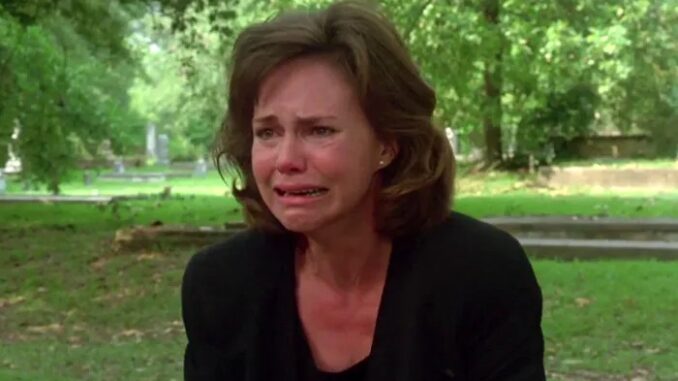
“We had this dazzling cast who were so loving and so supportive, and we had become so incredibly close. They were all crying off-camera. Then, when I was off-camera for them, I continued to cry.” Photo: TriStar Pictures
The cemetery scene in the 1989 film Steel Magnolias is an all-time, hall-of-fame, best-in-show cry scene, the kind of weighty, deeply emotional piece every actor dreams of playing. The key reason can be summarized in two words: Sally Field. As M’Lynn, a mother who has just lost her daughter Shelby (Julia Roberts) to complications from diabetes, Field careens through peaks and valleys of grief so raw that you can’t watch it with dry eyes. While pacing through a graveyard, she skates back and forth through the five stages of grief in roughly five minutes, and not one millisecond of it feels false.Surrounded by her closest friends — Clairee (Olympia Dukakis), Truvy (Dolly Parton), Ouiser (Shirley MacLaine), and Annelle (Daryl Hannah) — M’Lynn starts her extended monologue from a place that sounds at first like stage five: acceptance. “Shelby, as you know, wouldn’t want us to get mired down and wallow in this,” she said. “We should handle it the best way we know how and get on with it. That’s what my mind says. I wish someone would explain it to my heart.” From there, she recounts the final moments of her daughter’s life, when the machines in the hospital were turned off. “I was there when that wonderful creature drifted into my life, and I was there when she drifted out,” she said, her voice catching. This is when, as a viewer, you know you’re a goner yet still don’t fully understand how devastated you’re about to become.
Field then snaps suddenly from sadness to denial, saying she needs to get back to the rest of her family and checking her face in a compact mirror. Then she instantly dissolved again into grief spiked with extreme rage. “I want to know whyyyy!” she cries out, in a scream so primal it seems to come from the deepest cells in her bone marrow. Then she reverts to bargaining — “No, it’s not supposed to happen this way. I’m supposed to go first” — and immediately U-turns and drives right back into anger. “I just want to hit something, hit it hard!” she shouts.
A lesser actor than Field could seem out of control in a scene with so many whiplash-inducing turns, but she finds a way to remain simultaneously anchored and unmoored. No matter how often you watch her work here, it never loses its power.That’s because Field understands the importance of this scene, which she calls “the crux of the film.” She also credits her co-stars for their support and director Herb Ross for giving her the space to explore so much emotional terrain while the cameras were rolling, though she acknowledges that Ross wasn’t always as flexible with one of her co-stars. That’s just one of the things Field remembers about making this film and preparing for one of the most memorable wrenching scenes of her career.I’ve read that one of the main reasons you wanted to do Steel Magnolias is because of this scene. Is that true?
Yes. I mean, quite obviously it is a humdinger of a scene. But that scene was the crux of the film, because it is about loss and sadness and grief and rage, but ultimately it’s about friendship. It’s about these women who hang out with her. Every step of the journey she takes in that speech — she walks up and down the dirt road of the cemetery and they’re right there with her, feeling it with her, and ultimately they make her laugh. It’s about the very best of what women friends are.
Robert Harling, who wrote the play and the screen adaptation, based the story on his own family and the loss of his sister. How much did that weigh on you while you were making the movie?
It really is my task not to have it weigh on me. I have to pay allegiance only to the text and the actors around me and the world. It is the text that I have to work with, even though Robert and I became very close, and he will tell me things. I could hear that, but I had to be my own M’Lynn.He didn’t impose any information on me or say “She wouldn’t do that” or “My mother would never act like that.” Bobby knows that an actor has to create something that really joins the information and history on the page, but also the circumstances around you, and most especially the dynamics of all of those other actors.
The thing with film is that, good or bad, you need to catch it once. You need to catch this little moment. So it really is about all of those things and then, because of the way I was trained, it is most
